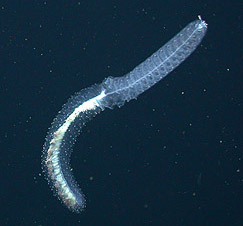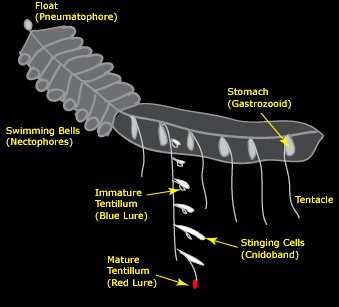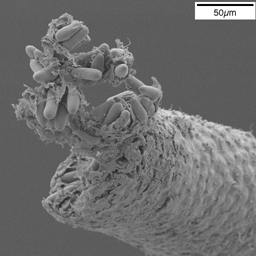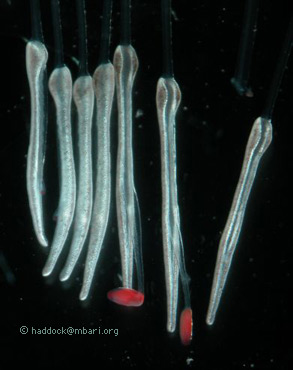 Of all the luminous organisms in the sea, only a few are thought to use light to lure prey, and fewer still have been known to make red light. (These red-light fishes are described on another page.) Recently, a siphonophore has been discovered which does both: it uses small red "lures" to attract prey. You can read the original paper or news reports elsewhere, but this page is intended to answer some of the more confusing aspects of this discoveries and give some of the story behind the story. UPDATE: The species was recently given a scientific name Erenna sirena. See references below. Of all the luminous organisms in the sea, only a few are thought to use light to lure prey, and fewer still have been known to make red light. (These red-light fishes are described on another page.) Recently, a siphonophore has been discovered which does both: it uses small red "lures" to attract prey. You can read the original paper or news reports elsewhere, but this page is intended to answer some of the more confusing aspects of this discoveries and give some of the story behind the story. UPDATE: The species was recently given a scientific name Erenna sirena. See references below.
So what is a siphonophore?
Siphonophores are in the phylum Cnidaria, which includes corals (Anthozoa), and the familiar "true" jellyfish (Scyphozoa). Siphs (as they are sometimes called) are within the Hydrozoa, which includes hydroids that grow on rocks, as well as the small and transparent jellies called hydromedusae.  They are not, as some might tell you, colonies of single-celled organisms, nor do they "come together" to form a colony. There is a more thorough discussion of their coloniality at siphonophores.org, but for our purposes, it is easiest to consider them as a single "superorganism", which grows by budding off specialized polyps and medusae. (Coloniality comes in when you consider the polyps as individuals.) Each type of polyp has a special function, including feeding, buoyancy, propulsion, and reproduction. They are not, as some might tell you, colonies of single-celled organisms, nor do they "come together" to form a colony. There is a more thorough discussion of their coloniality at siphonophores.org, but for our purposes, it is easiest to consider them as a single "superorganism", which grows by budding off specialized polyps and medusae. (Coloniality comes in when you consider the polyps as individuals.) Each type of polyp has a special function, including feeding, buoyancy, propulsion, and reproduction.
Siphonophore Feeding
Of special interest here are the feeding polyps, known as gastrozooids. In the genus Erenna, each gastrozooid has a tentacle which branches off of it from the base. This tentacle, in turn, has side branches called tentilla, which hold the stinging cells. 
Most siphonophores catch prey by putting out their long tentacles and waiting for something to bump into their tentilla. Think of a spider web which is also laced with stingers. But not all siphs operate in this way. Using MBARI's deep-diving remotely operated vehicles, we found a new species in the genus Erenna. Siphonophores like Erenna, especially the new species in question, don't seem to follow this same passive mode of operation. When seen from a submersible, this species holds its tentacles close to its body. On the face of it, this would not seem to be an efficient feeding strategy.
What makes this species more unusual is that it is known to feed only on fish, and it lives more than 1600 meters deep, where fish and other organisms are relatively scarce. So without a web, how does it catch its food?
The trap is set
 A clue is found in the arrangement and "behavior" of the tentacle side branches. The side branches include a large battery of stinging cells attached to a central stalk. Several examples of these are shown at the right. At the end of the transparent stalk is a red "lure" which starts out small with a white center. The white material consists of bioluminescent material. As the small lure matures, it gets larger and the white material becomes surrounded by red fluorescent material. A clue is found in the arrangement and "behavior" of the tentacle side branches. The side branches include a large battery of stinging cells attached to a central stalk. Several examples of these are shown at the right. At the end of the transparent stalk is a red "lure" which starts out small with a white center. The white material consists of bioluminescent material. As the small lure matures, it gets larger and the white material becomes surrounded by red fluorescent material.
Based on the emission and excitation spectra of this red substance, blue light emitted at the center of the lure would be expected to excite the fluor and produce orange-red light. This wavelength of light is very unusual in the ocean for two reasons. One is that it doesn't penetrate very far: meters or several centimeters rather than tens of meters. Because red light is rare, it is not surprising that the eyes of deep-sea organisms have only rarely been found to be sensitive to red light.
The lures are not just capable of producing light, but the transparent stalk also contracts rapidly to flick the lure. This behavior is eerily similar to the motion of many deep-sea copepods. Often they are seen to do a "hop and sink" behavior where they alternate between rapid jumps and slow sinking behavior. If a copepod-eating fish were able to see the motion of the lure, it would almost certainly be a tempting target!
Red menace?
Conclusions
The use of a dim red lure in the deep sea is almost impossible to observe undisturbed. Any illumination would obviously affect the visual environment, and a low-light camera would be hard pressed to find these rare siphonophores, let alone document a feeding event. Nonetheless the most conservative interpretation of the evidence seems to be that this jelly dangles red lures to attract its prey. If more specimens can be obtained, there are many avenues for further study of this special function of bioluminescence.
|
|
|
|
References and Additional Reading:
- Pugh, P.R. and S.H.D. Haddock (2016). A description of two new species of the genus Erenna (Siphonophora, Physonectae, Erennidae), with notes on recently collected specimens of other Erenna species. Zootaxa. 4189: 401-446. [ PDF ]
- Haddock, S.H.D., C.W. Dunn, P.R. Pugh. and C.E. Schnitzler. (2005) Bioluminescent and red-fluorescent lures in a deep-sea siphonophore. Science. 309: 263. [ Look for the special link PDF here. ]
- Pugh, P.R. (2001) A review of the genus Erenna Bedot, 1904 (Siphonophora, Physonectae). Bull. Nat. Hist. Mus. (Zoo. Ser.) 67: 169-182. [ PDF ]
- Douglas, R.H., J.C. Partridge, and N.J. Marshall (1998) The eyes of deep-sea fish. I: Lens pigmentation, tapeta and visual pigments. Prog. Ret. Eye Res. 17: 597-636.
- Douglas, R.H. and J.C. Partridge (1997) On the visual pigments of deep-sea fish. Journal of Fish Biology 50:68-85.
- NPR story [ Link to Audio File ]
- Broad, W.J. (2005) "Cousin of the jellyfish spurs fresh theories on seeing red" New York Times. [ Link to Article (Free Registration req'd) ]
|
|
|
 Of all the luminous organisms in the sea, only a few are thought to use light to lure prey, and fewer still have been known to make red light. (These red-light fishes are described on another page.) Recently, a siphonophore has been discovered which does both: it uses small red "lures" to attract prey. You can read the original paper or news reports elsewhere, but this page is intended to answer some of the more confusing aspects of this discoveries and give some of the story behind the story. UPDATE: The species was recently given a scientific name Erenna sirena. See references below.
Of all the luminous organisms in the sea, only a few are thought to use light to lure prey, and fewer still have been known to make red light. (These red-light fishes are described on another page.) Recently, a siphonophore has been discovered which does both: it uses small red "lures" to attract prey. You can read the original paper or news reports elsewhere, but this page is intended to answer some of the more confusing aspects of this discoveries and give some of the story behind the story. UPDATE: The species was recently given a scientific name Erenna sirena. See references below.
 .
| Research forum | Bioluminescence Info Page.
.
| Research forum | Bioluminescence Info Page. They are not, as some might tell you, colonies of single-celled organisms, nor do they "come together" to form a colony. There is a more thorough discussion of their coloniality at
They are not, as some might tell you, colonies of single-celled organisms, nor do they "come together" to form a colony. There is a more thorough discussion of their coloniality at 
 A clue is found in the arrangement and "behavior" of the tentacle side branches. The side branches include a large battery of stinging cells attached to a central stalk. Several examples of these are shown at the right. At the end of the transparent stalk is a red "lure" which starts out small with a white center. The white material consists of bioluminescent material. As the small lure matures, it gets larger and the white material becomes surrounded by red fluorescent material.
A clue is found in the arrangement and "behavior" of the tentacle side branches. The side branches include a large battery of stinging cells attached to a central stalk. Several examples of these are shown at the right. At the end of the transparent stalk is a red "lure" which starts out small with a white center. The white material consists of bioluminescent material. As the small lure matures, it gets larger and the white material becomes surrounded by red fluorescent material.